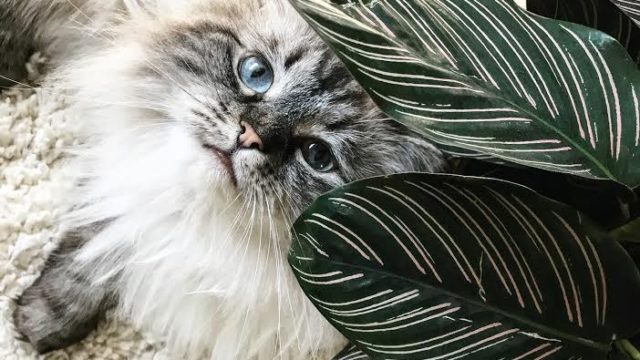
There’s a feeling when you first discover a new houseplant. It’s partly love and fascination, yes, but I’ve noticed plant parents become obsessed. Not just like, “oh I need to have this houseplant” but will-walk-to-the-ends-of-the-earth to find it obsessed. Right now, aside from a variegated Monstera, which I am finding is impossible to locate, I have a newfound love for Calathea. And it’s that kind of obsession. I mean, where have these been? Plus they’re deliciously non-toxic for pets, so yes, I’m in love with Calathea and must have all of them.

Both Calathea and Maranta are commonly known as Prayer Plants. Their variegated leaves actually fold up at night, which conserves moisture, and allows them to pray to the plant gods. Part of the family Marantaceae, Calathea are cousins to Maranta, which are just as gorgeous. Typically I’ve seen both plants dubbed as “the perfect beginner” plant.
Hold the phone.
I wouldn’t call Calatheas easy – they actually come with a bit of sass and need certain conditions to actually grow well. They grow best in greenhouses and Brazil, so unless you live in either one there’s a bit of learning involved. It’s possible though, to create these conditions so your plant can be happy.
Types of Calathea
Honestly the best place to see all of the different types of Calathea are Instagram, so I brought my favorites here to flaunt with the help of The Gardening Queen on IG:
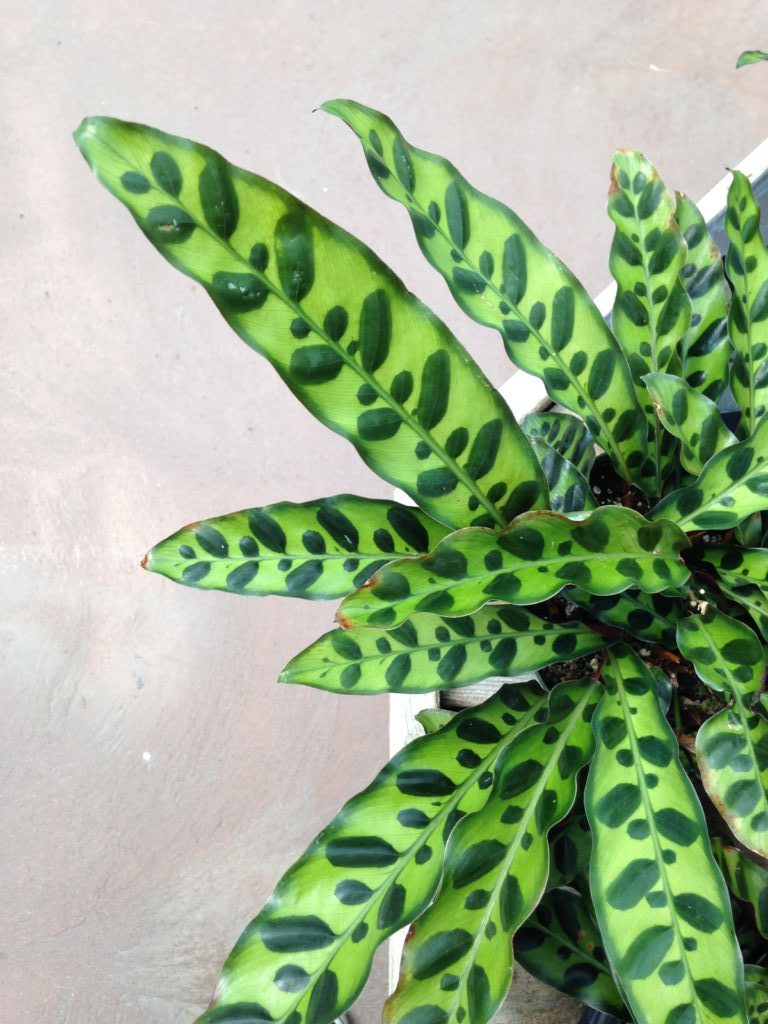

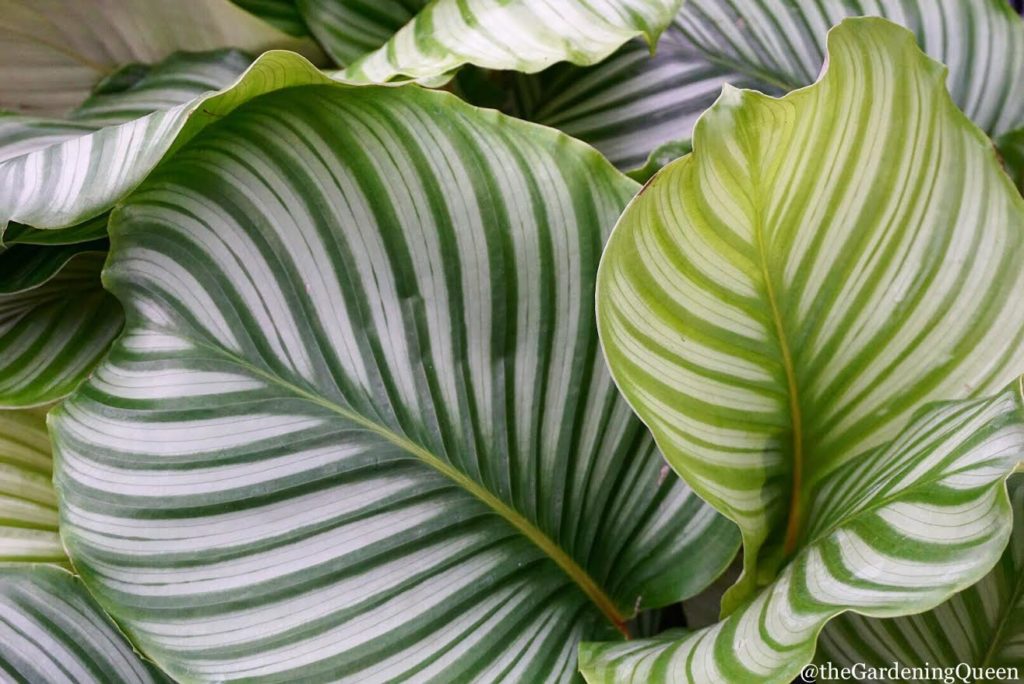
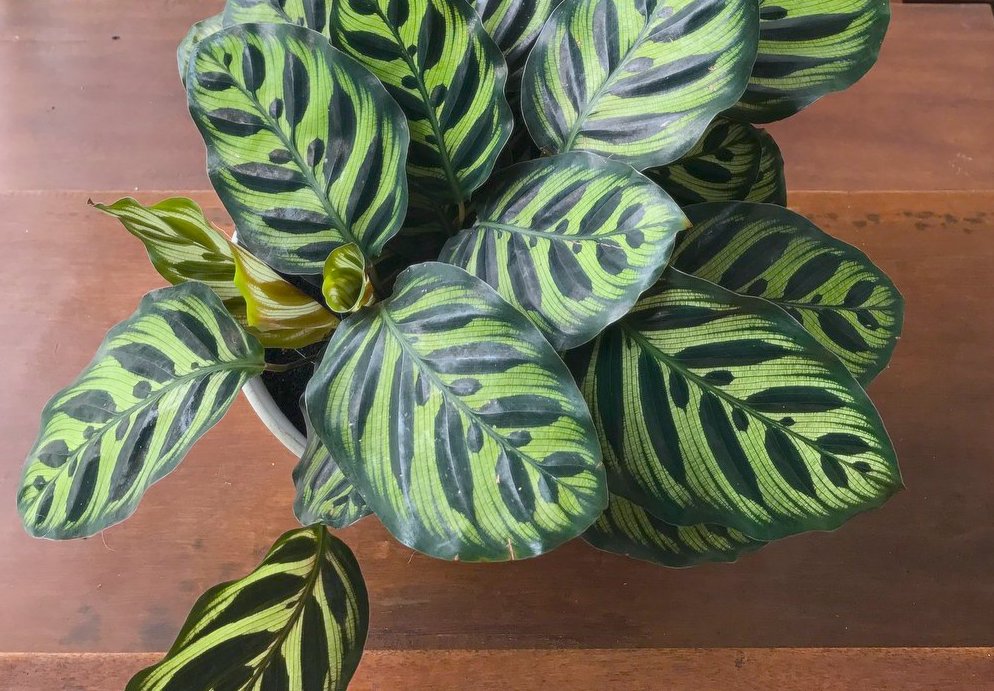

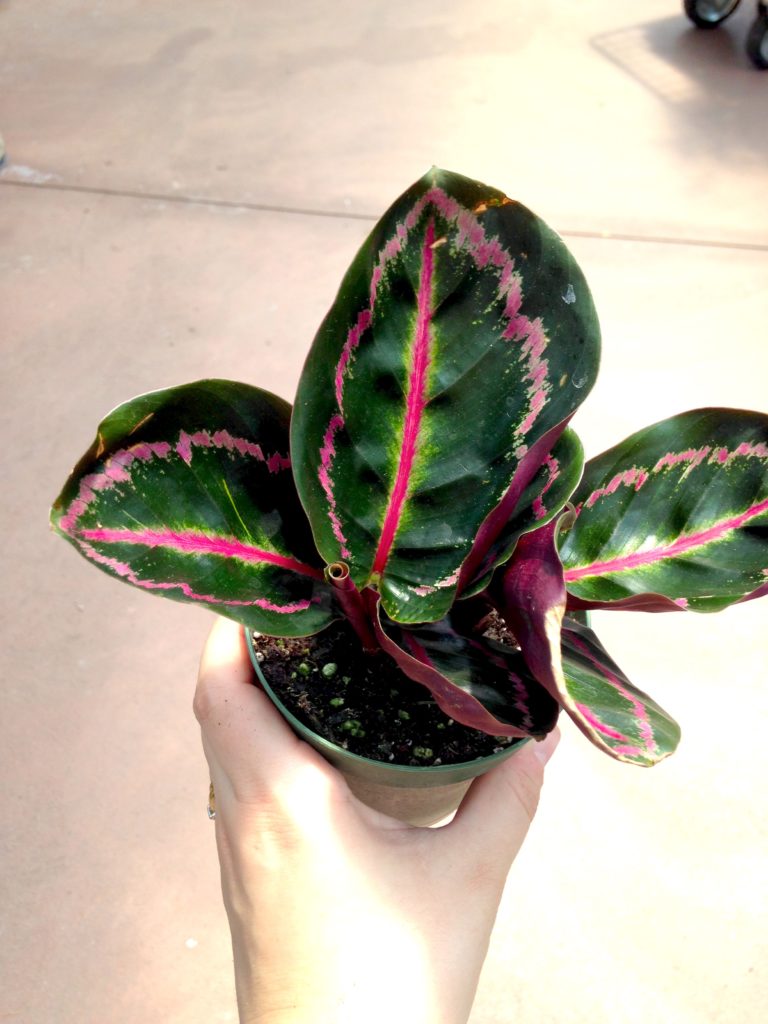
Calathea Care
Calatheas are crazy pretty, safe for cats and safe for dogs and purify the air. I’ll just remind you once more that these aren’t a beginner plant – just remember that your love for them will trump this challenge. No, actually it won’t, so here’s some helpful tips.
In nature, Calathea are found at bases of trees and their leaves are meant to hold and distribute water. With this in mind, Calathea are notoriously killed by over or under-watering. Plant parents typically see brown tips on leaves and assume more water is needed. I’ll get more into this in a bit, but that’s not quite right. Most often than not, the plant is fine on water, and it’s some other condition causing the dry tips.

Light: The best conditions for Calatheas are bright and indirect light, like a east or west window behind a sheer curtain. Direct light dries the leaves almost instantly. To keep the variegation, these guys need a decent amount of light but too much will cause it to fade.
Humidity: These are found in the jungle, which means tons of humidity. Dry air conditions affect the leaves drastically, producing brown tips and crunchy stems. To keep humidity high, you can do either of all of the following:
- Place these on a pebble tray (like here).
- Mist, but just a bit. Moisture is absorbed into their leaves which keeps them healthy. If you mist, use non-chlorinated water only. Since Calathea are prone to bugs, check your stems and undersides of leaves often if you mist weekly or more.
- Run a humidifier. Better than misting, this is what I do all winter and, sometimes, into summer. A humidifier keeps my Monsteras healthy and my Calatheas are usually chillin’ nearby.
Watering: This is the trickiest part of Calatheas, because there is no piece of advice I can give you about watering. Basically, depending on the temperature of your house and the humidity level, your Calathea may need water every week or every day. The biggest thing to remember: don’t let them dry out. They like to be kept moist, like a wrung out sponge.
I’ve seen a few care guides suggest letting these dry out between waterings. Do not do this. Why it’s suggested I don’t know, but their lifespan quickly decreases with any drying out period. When Calathea do need a drink, there are a few early signs (aside from the soil being dry) to look for. Leaves that remain closed throughout the day, dry leaves and roots sticking out of the bottom of the pot are all bad signs. They’re not happy this way and go downhill fast.
Potting: Always plant Calathea and Maranta in pot with a decent amount of drainage. Since over-watering is common, planters without any drainage encourage root rot, which is bad. After watering, always let excess water from the pot.

Problems with Calathea and Maranta
I’ll be honest with you – Calathea and I couldn’t seem to jive. Finally, I sat down and monitored their health for a few months closely and implemented all of the suggestions I mention above (which is why I wrote this). Finally, my Calathea orbifolia, Marantha Lemon Lime and Stromanthes (also related to the Calathea family) are going strong.
Some common Calathea problems are –
Brown leaves or brown tips: See some brown edges? It’s ok, don’t freak out, since it’s pretty common. Inconsistent watering habits are the main offender. It can also be over-feeding and low humidity. Always water until it comes out of the drainage holes, and never water in small amounts. After modifying your watering habits, monitor new growth – you may need to still adjust humidity levels if you’re still seeing brown tips.
Folded up leaves: This means your Calathea needs water. Give her drink for God’s sake.
No color and no variegation: Has your Calathea producing new just green leaves? Most likely, your plant baby is in a too-shady spot (see my plant with Harvey below). Depending on what type of Calathea you have, you’ll have to change the amount of light it receives. Red Calathea do better in lower light, while green and white Calathea need brighter locations to keep their variegation.
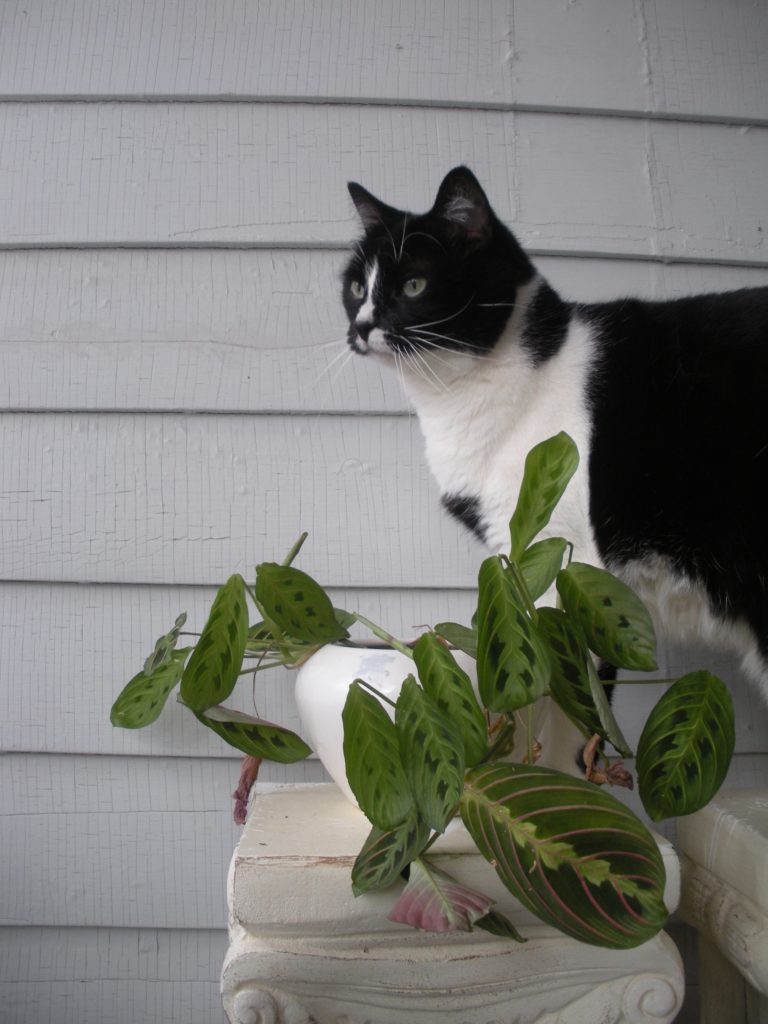
Propagate your Calathea
Calathea are some of the easiest plants to propagate. Unlike other plants like succulents and Monsteras, Calatheas are propagated by division, like hostas. You’ll want to work with healthy and established mother plants only. Do not attempt propagation if the plant is immature or throwing tantrums.
I’ll have a blog post about this soon, but here’s a quick step by step guide:
- Step 1: Protect the plant with your hands and turn it over (similar to as if you were re-potting) and take it out of the pot. If there are any crowding issues, gently loosen the pot so the plant can slide out.
- Step 2: Using your fingers, pull the roots apart to separate them. Be sure not to pull out hard or break any roots – this step is merely so you can easily see what you’re working with.
- Step 3: Once you split the roots a bit, figure out a chunk you can take off – the cutting must contain a leaf and roots for it to survive. Be sure to have a pot ready for the child plant. You’ll need to use the same soil mixture the mother plant had, so the baby plant can acclimate easier.
- Step 4: Snip/tear this piece from the mother and set inside her new pot. Water thoroughly and make sure all water has drained out.
- Step 5: Keep the new plant out of bright, hot sun and instead keep in a cooler location with part shade. Keep humidity high; you can either place the plant on stones or put in a plastic freezer bag with the top mostly open. Give her a few weeks, and you should start to see new, baby leaves!
I hope this post helps solve some (common) Calathea problems and prompts you to grow happy and healthy plants. I also wanted to mention that a name change occurred in 2021 – Calathea lancifolia , or Rattlesnake plant, changed to Goeppertia insignis.
Special thanks to Vanessa, The Gardening Queen, for her contribution and amazing photos of her Calathea collection.

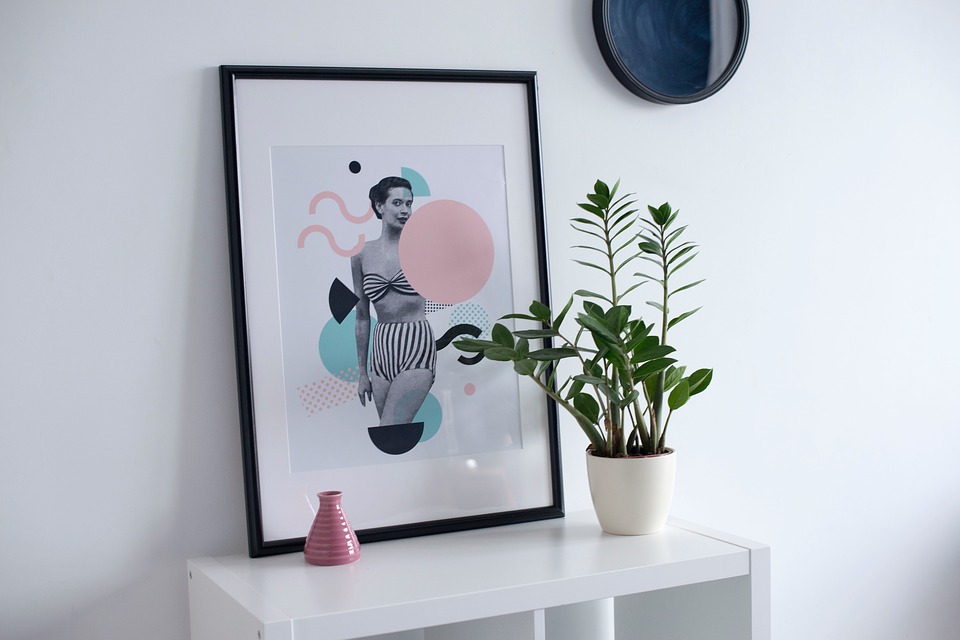
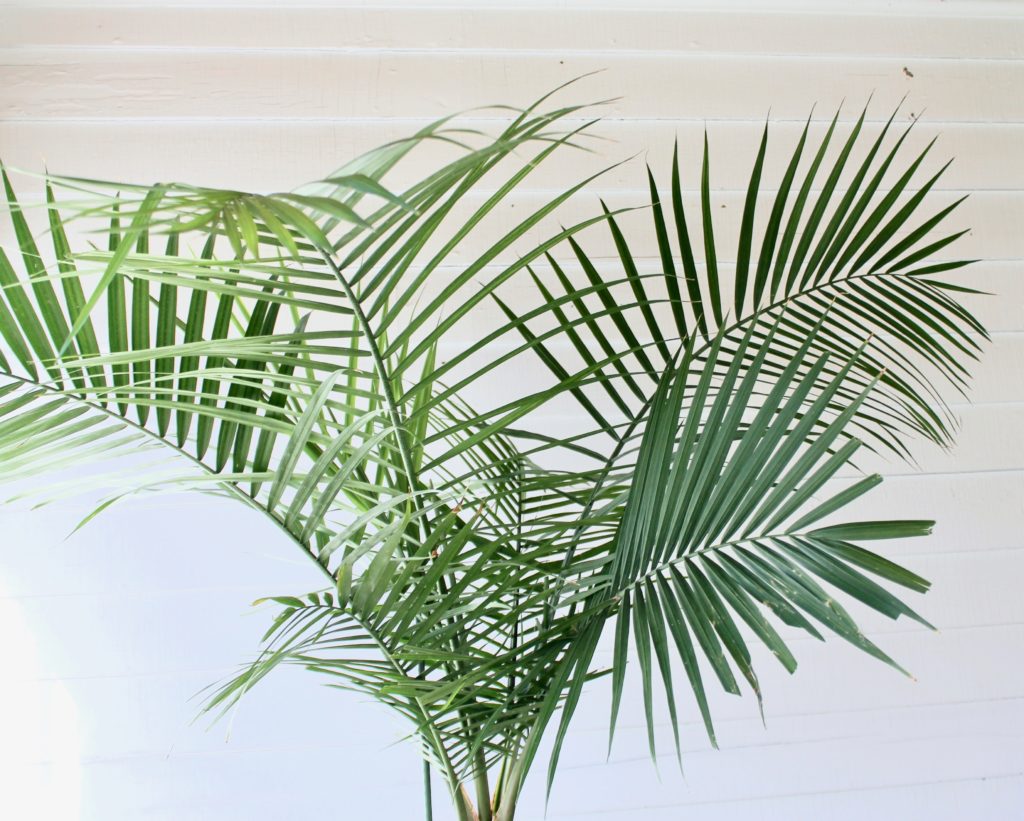
I jsut recently got a calathea. Well, not recently, a while ago I got one, a pin-stripe. but just the other day I got another. I’m thinking it’s a zebrina.
They are both so beautiful. I can’t stop looking at them and smiling same time!
Idle head
Aren’t they just beautiful?! I’m so in love with Calathea.
Thank you so much for your information on calatheas..I’ve now required 5 and I actually live in Ireland so not that warm however I mist most days and I’ve noticed one of them is slightly Brown tipped so misting it more of her however it’s shooting up 5 new leaves as the other similar one …so can’t be doing to bad…Great piece ??
Thank you!
So glad that I landed here.
I adore these plants! Unfortunately my cat literally ate half of my new Maranta, so it’s a good thing they’re pet safe! 🙁 Hopefully I’ll have better luck with my next one (which I plan on tucking high and out of munching range)!
Oh no! The good news is Maranta looks lovely in hanging planters – plus it’ll be a lot safer up high. 🙂
I have two caletheas. They surprisingly lasted for 4 weeks of self watering, while I was away on vacation but I came back to a nasty gnat infestation. I let them dry out between watering to get rid of the gnats but one of them never recovered ? After that I definitely agree with your suggestion to never dry out. Wish I would have read your post before I did it!!
Oh no! Gnats are seriously the worst. For future infestations, especially on calatheas, I would repot instead and add some fresh soil and some sticky fly paper near the plants. Good luck!
Hi my calathea ended up with a tear in the middle of the leaf. I dont know how really. Is it safe to leave it be or should i just take it off? Thanks for any advice.
Hi Cez, it’s up to you, really. Personally I like to remove damaged leaves (as long as the plant has many others) so that its energy can focus on creating new ones. It won’t hurt the plant to leave it either.
Hello im a newbie in parent for my calathea pin-stripe and im kinda freaking out because the tips of their leaves turns brown, then there are three new leaves growing and it also has brown tips…i dont know what to do…can you help me with my problem? My room doesnt receive direct light from the sun, my humidity level here in manila is arou 50 to 65…. i dont have the idea what went wrong with my baby thea…
Hi Yan! Calathea are very finicky and if you have any heat in the house it can make the leaves dry out. Make sure you are watering the plant thoroughly when it is barely moist and letting all the water drain out, Calathea do not like to sit in water. They do like sun and I would actually put it in a brighter spot – that seems to help them whereas shady spots tend to make them have problems. I hope that helps!
Also try using distilled or filtered water. They don’t like all the florine and choramine found in tap water.
My Calathea Ornata has the problems already mentioned (curling, yellowing leaves) but I noticed that some of the stems are splitting. Any suggestions?
Hi Dawn, hmm, without seeing a photo I’m not sure what you mean by splitting, but it could be a watering/humidity problem, which is causing the other leaf issues you have. Feel free to send a photo to Leaf and Paw’s Facebook page and I’d be happy to take a better look!
I have a gorgeous calathea lancifolia I keep in my shop. It’s thriving. When I got it I was told by an horticulturist friend not to give it too much water. That’s advice I’ve interrupted as ‘let it dry out before you water’. That’s what I’ve done to this day. She has been bone dry before. Plants at my shop have to be able to stand that because sometimes I just get busy and forget. So I suppose it depends on the type.
which species of calathea have thicker leaves, like the rattlesnake? I’ve had back luck with white fusions and marantas as their leaves are much more delicate, but the rattlesnake thrives. thanks!
The calathea orbifolia have thicker leaves, still not as thick as the rattlesnake calathea, but I find they are similar in temperament. They are a bit more durable than the white fushions which can be super finicky, but they still need high humidity. Hope that helps!
I propagated my prayer plant by cutting below tne node and p,aced in water. I have small roots now and will soon plant and new plant!!
Congrats Patti! I hope it grows up to be big and strong. 🙂
Lots of sound good tips here. Sunset Blvd Nursery has many varaties available.
Hi! Oh my calathea orbifolia is the plant that keeps me guessing and completely frustrated. At first I thought I received a lemon, possibly just a poor quality plant. Nothing I do seems to make her happy. However, this summer (I’m in the southeast with lots of humidity) I put her outside and she seems to be doing better since I cut off all the leaves that were mostly brown and crispy. I water her regularly and have her in well draining soil, under the eaves of my home so its bright but not direct light. My main issue aside from browning leaves is that they don’t get much bigger than a few inches across. Any thoughts??? She’s driving me crazy but I love her so!
Hi Abby! Sounds like you are doing everything right! If you cut off all of the leaves, though, she is basically starting from scratch, so the leaves will probably be smaller initially but she should be growing new, bigger leaves as she regains her strength. As far as brown leaves, don’t be alarmed if the tips are brown on any Calathea (especially orbifolia), it seems to happen all the time even in perfect conditions. Hope that helps!
My Calathea experienced some burning after too much light. I moved her into indirect light and her leaves unfolded, but the tip of one is still really brown/yellow/crispy. There are 3 others that are fine. There hasn’t been any new growth though, so I’m worried. Is there anything I can do to remedy this? Also, I think some gnats from my Philodendron hopped over onto the Calathea. SOS 🙁
Uh oh! Calatheas are definitely sensitive to light – they like indirect light and warm temperatures with high humidity. Right now she isn’t happy, so I wouldn’t trim any leaves off of her yet, but keep her in a place where humidity is high until new growth starts. I had a similar situation happen and it just takes some time for them to recover. As far as gnats, place some sticky fly tape near her soil and never let them stand in water. That should help.
Hi! I’ve had my calathea ornanta for a few years now. When I first got it, the leaves all grew low down, close to the soil, but over time they have shot up so now I just have three leaves with the tallest one about a foot up. They also are all pointing up instead of lying flat. Any ideas on what’s happening or what I can do to fix it?
Thank you very much for your detail information.
I am amatuer gardener Recently, I purchased Calathea plant from the nursery. when I saw it , I tempted to purchase though it was expensive. I want to develop it nicely. Details provided here are highly Informative & educative . I will regularly follow UR sight for others
What an incredibly insightful article. I’m a new plant parent and have three beautiful Calanthea babies. Loved reading your detailed observations about them. Thank you so much.
Thank you Sujata!
Thanks for this post! Although you’re running thru the basics., I have to say, your advice is solid,and the best is the way you’re addressing the different types. This way you are reaching more people who love calatheas.❤️
Aw thanks, Lisa! <3
Hello. I am a new Calathea parent. Thanks for the info. It will help me in taking care of my lovely red one. Your cats are so cute!
Thank you Nora!
Wow, amazing blog layout! How long have you been blogging
for? You made blogging look easy. The overall look of your website is wonderful, as well as the content!
Thank you for the information. I have recently become obsessed with calathea. I just received a Calathea Makoyana Peacock plant in the mail
It looks healthy with alot of new leaves ready to come out but the leaves are mainly dark green without variations! I will try putting it in a bright spot to see if this helps. Will the green leaves change color or do I have to wait for the plant to grow more?
Hi Lauretta, Congrats on your plant baby! Calathea really need bright indirect light – so I always have mine a few feet from a window so they don’t get harsh sun and that helps with coloring. The existing leaves won’t change, only new leaves will have the variegation.
Hi I’m new to the calthea but not to houseplants and gardening anyway I might be nuts but I think my Calathea tries to fold its leaves up towards the ceiling at night and then in the morning when I wake up it seems like they’re all where they’re supposed to be is that a thing
Totally is, Calathea and Maranta’s leaves constantly open and close during day and nighttime. That’s totally normal and means they’re happy plants.
Hello!
Thank you so much for this informative article! I’ve just gotten my first two calatheas. One is a calathea medallion that I’ve noticed has a couple (very small, like a speck of rice) spots on a few of the leaves. I know this plant can be finicky so I just want to make sure it isn’t the beginning of a problem. I’ve got the calathea sitting directly in front of a humidifier and it’s about four feet from a window but behind a sheer curtain. I water it every 3-5 days with distilled water. Do you have any suggestions for what I might be doing wrong?
Thank you!
Hi! Thanks for reading! Spots can mean anything really (especially without me seeing them), but the conditions where you have your plants sounds perfect and they should be healthy. Calatheas are most sensitive to tap water, so if you have city water, hard water, etc, this can cause spots quickly. I would fill a water jug and let it sit out 24 hours or collect rainwater to water them.
Hi, I just bought a new Goeppertia concinna calathea a few days ago. It was just watered in the shop that I bought it from so I haven’t done it yet at home. It gives new leaves and the first ones were super – green and full of color but now all the new leaves even in the baby form are yellow almost transparent. I don’t understand why is this happening? Is it because of light or lack/too much water? Do you have any idea what can be causing this?
Thank you 🙂
Hi Sib! Calathea leopardina need to be just lightly moist, never sopping wet and they do need decent non-direct light in order to keep their color. On many Calathea, new leaves are sometimes not the color of mature leaves, so the baby leaves can look yellow or lightly green. Give them a few days – if they are not growing and turning opaque you may have some issues, but it just sounds like how young Calathea leaves typically look. Keep me posted!
Hi,
I just found your blog and I really hope you can help me! I just got a Calathea Makoyana about two week ago, she was really happy and just appear 2 new leaves, but suddenly a center leaf turned yellow brown ish and I found 2 mini white spiders and one reddish
I am fraking out! Hope you can help me! Thank you!!!
Hi Paola, Sounds like possibly mealybugs (white bugs) or thrips (black bugs). Either one can be taken care of with an insecticide, I like Bonide products, personally. As far as that yellow leaf that could also be a watering issue. Be sure your plant is in a bright spot without direct sunlight and make sure you aren’t overwatering. Keep me posted!
Great article- I’ve just got myself a Calathea Ornata (named Bill). I’ve put him in a North-West facing window, which means he gets about 2 hours of direct sunlight late afternoon. I’m having kittens about whether to move him away from the windowsill and into the room – our house is very dark, a proper old terrace house – and so the rest of the room is pretty dark most of the day! I’m really torn, as there’s a lot of information suggesting a North-facing window is a good idea, but West might be too harsh without a filter…. and I’m exactly halfway between at NW.
I’ve had Bill a week and he seems pretty content; he arrived with one brown-tipped leaf, but so far he’s not showing signs of any more distress.
I’m worried about the direct sunlight, but also worried about him not getting enough! What would you suggest? (I’m a new plant mum, and going by how the last month has been, I think it’s good I don’t have *actual* children!)
Hi Em! Can I just say I love the name Bill? Honestly, I would keep him in a North window. If you find his colors are fading that is an indicator he may need brighter light. The biggest thing with Calathea is no harsh light and lots of humidity. They are always so much happier in non direct light. Just be mindful of watering – since he’s not in super bright light, water only when the soil is slightly moist. These guys don’t like to dry out. You can also keep him in a mini greenhouse, that will help with humidity.
Hi! Thankful to have gone to your blog!
I just got 4 varieties of calathea, and since my space is small, I was thinking of putting them together in one big pot. Is that a good idea?
Hi Naomi! You can, but be sure they have room to grow and the soil has drainage. Also they need quite a bit of humidity so grouping them will help with that, but be careful of overwatering. Good luck!
Hi, i have bought few baby calathea plants in 6cm pots when is the best to transfee them in 8cm pot. Thank you
I would keep them in their pots original pots for a bit, as soon as they “outgrow” their 6″ you can repot to 8″. For Calatheas it’s usually a few months.
Greetings! I received a calathea zebrina via mail. Unfortunately, a VERY hungry worm came along and ate several leaves which I discarded. At the seller’s recommendation, I used Neem spray and quarantined this plant from my others. The spray directions did not specify for how long to continue weekly treatments.
The plant seems fine now and has new growth but the Neem spray may have caused some of the leaves to turn yellow around the edges. Do you have a general rule of thumb for the duration of insecticide treatment?
Hi Stacy! It really depends on the type of pest, but for a single worm I’d say a few applications are fine until you no longer see them come back. It usually takes a few weekly applications but I wouldn’t go too much more than that since Calathea leaves are gentle. Honestly, if you have issues with worms/caterpillars, you may want to get a small greenhouse (Ikea has one I like) to keep larger pests like that out.
Hi! This post is really great, I’ve read so many articles about letting the soil dry an inch or two before watering and when I did this i damaged the foilage kf my calathea beauty star and Stramonthe Triostar were permanently! Anyway I took apart the roots of my calathea beauty today because it just keep deteriorating even though I give it perfect conditions. I found that its core roots were tightly stuck in the soil mould of its 1 inch growing pot. I carefully took it apart and was too afraid to put it back in soil after the trauma it must have just gone through so I decided to put it in distill water. Do you know / have had any success with rehabbing these plants in water?
I have not tried to root Calathea in water – but it might be worth a shot! I did have luck taking a chunk like you did and just repotting it in moist soil and putting in a warm location.
Hi, thanks for this guide! I fell in love with calatheas, and have managed to keep the 4 that I have relatively happy, except for my leopardina.. She had a bad case of spider mites a few months ago, which I treated with a small bit of vinegar and soap mixed with water, and later on with neem oil mix. It worked but the leafs are slowly starting to turn translucent 🙁 Any idea on how to stop this? I think she gets enough water and I mist regularly..
Hi Tamara, oh spider mites are the worst and they looooove Calatheas. I would just keep at it with neem, but maybe do once every month instead of every week (or however often you are applying) so it’s not as intense. Because Calatheas are pretty temperamental too much neem can hurt the leaves (but again, so can spider mites) so you may have to cut all the leaves off and start from scratch. They’ll grow back, I’ve had to do this a number of times. I also wouldn’t mist, sometimes this actually makes the leaves look worse and doesn’t really help them. Good luck!
Aloha, I am new, I just bought a little (6”pot) rattlesnake plant and knew nothing about it other than it is beautiful. Thank you for the wealth of info!
I have like 3 10” leafs and a bunch that haven’t opened yet. My question is about the little baby leafs at the base. There are tons and they don’t seem to have room to grow in between the stems of the larger leafs.
If I were more confident, and this type plant weren’t so temperamental, my instinct would be to separate them so the littles have room to grow.
Should I wait until she gets more comfortable in her new home? Or do it ASAP? I do need to move her out of her plastic pot soon. Maybe when I move her, I should just spread her out a bit?
Hi Abby! I believe those are new baby plants which aren’t hurting the plant at all, and are signals that you have a very healthy one. Calathea do not mind at all being root bound, some even prefer it, so I would wait until she is more comfortable and accustomed to your home to do any splitting. Many people make the mistake of repotting right away and it just adds more stress to the plant’s rehoming. After 6+ months, I would reevaluate and you may be able to repot.